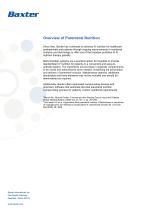 Website:
Baxter
Website:
Baxter
Catalog excerpts

Overview of Parenteral Nutrition Nutrition is an essential part of life, and this need is often amplified by acute or chronic illness. Yet, several studies indicate an estimated 30 to 50 percent of U.S. hospitalized patients show signs of malnutrition,1,2,3 which can occur as a result of an imbalanced diet, impaired digestion or absorption of nutrients, or other medical conditions when metabolic requirements exceed intake. Malnutrition is a global problem — studies have shown as many as 40 percent of hospitalized elderly patients in Canada and nearly 40 percent of hospitalized patients in Europe suffer from malnutrition.4,5 Left unmanaged, it can increase morbidity and mortality and lead to serious health complications, including extended hospitalization.6 Parenteral Nutrition Therapy Some patients are unable to consume nutrients orally because of their condition or because they do not have a functioning gastrointestinal tract. These patients must be fed via an alternate method such as parenteral nutrition. Parenteral nutrition is intravenous (IV) administration of nutrition, which may include protein, carbohydrates, lipids (fats), vitamins and other trace elements for patients who cannot ingest food orally or enterally (tube-fed). Striking the correct balance of nutritional content in a timely manner can help combat complications and be an important part of a patient’s recovery. For example, patients who have undergone trauma (such as surgery) experience a breakdown in muscle mass to support healing, so they need protein to help replace the lost muscle mass. 7 Hospitalized patients also need energy supplied by carbohydrates, but supplying too much can lead to hyperglycemia (excessive sugar in the blood), and can impact clinical outcomes.8 Parenteral nutrition therapy requires constant monitoring and maintenance to ensure a patient’s needs are being met. Baxter’s Leadership in Nutrition Baxter has been assisting clinicians in treating patients’ diverse nutrient needs since the 1940s, when the company first introduced liquid proteins in the form of amino acids. Messner RL, Stephens N, Wheeler WE, Hawes, MC. Effect of Admission Nutritional Status on Length of Hospital Stay. Gastroenterol Nurs. 1991 Spring;13(4):202-5. 2 Giner M, Laviano A, Meguid MM, Gleason JR. In 1995 a correlation between malnutrition and poor outcome in critically ill patients still exists. Nutrition. 1996 Jan;12(1):23-9. 3 Robinson MK, et al. Improving nutritional screening of hospitalized patients: the role of prealbumin. JPEN J Parenter Enteral Nutr 2003 27: 389 4 Laporte M., Villalon, L., Payette H. Simple Nutrition Screening Tools for Healthcare Facilities: Development and Validity Assessment. Can J Diet Prac Res 2001; 62:2634. 5 Kondrup J, Sorensen, JM. The Magnitude of the Problem of Malnutrition in Europe. The Economic, Medical/Scientific and Regulatory Aspects of Clinical Nutrition Practice: What Impacts What? Nestle Nutr Inst Workshop Ser Clin Perform Program, vol. 12, pp 1-14. 2009. 6 Isabel M., Correia TD, Waitzberg D.The impact of malnutrition on morbidity, mortality, length of hospital stay and costs evaluated through a multivariate model analysis. Clin Nutr 2003;22 (3): 235-239.
Open the catalog to page 1
Overview of Parenteral Nutrition Since then, Baxter has continued to advance IV nutrition for healthcare professionals and patients through ongoing improvements in nutritional contents and technology to offer one of the broadest portfolios of IV nutrition therapy globally. Multi-chamber systems are a practical option for hospitals to provide standardized IV nutrition for patients in a convenient and easy-toactivate system. The ingredients are provided in separate compartments to be mixed and administered when needed, simplifying the prescription and delivery of parenteral nutrition....
Open the catalog to page 2All Baxter catalogs and technical brochures
-
FOLFusor
1 Pages
-
PRISMAFLO IIS Blood Warmer
2 Pages
-
The PRISMAFLEX System
8 Pages
-
PRISMAFLEX System
4 Pages
-
NPVC-prismaSATE
2 Pages
-
Rockwell
4 Pages
-
ABACUS
10 Pages
-
Science & Innovation
4 Pages
-
Renal
4 Pages
-
BioScience
1 Pages
-
PRICE LIST & PRODUCT CATALOG
50 Pages
-
FLOSEAL Hemostatic Matrix
2 Pages
-
Baxter?s Medical Products
2 Pages
















